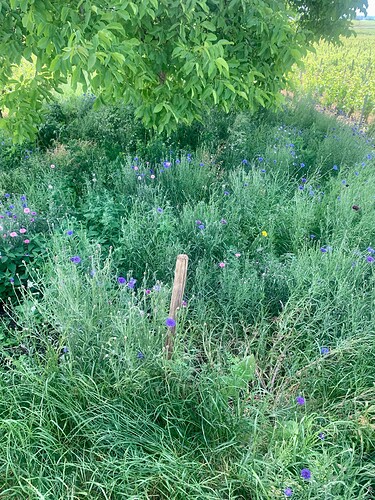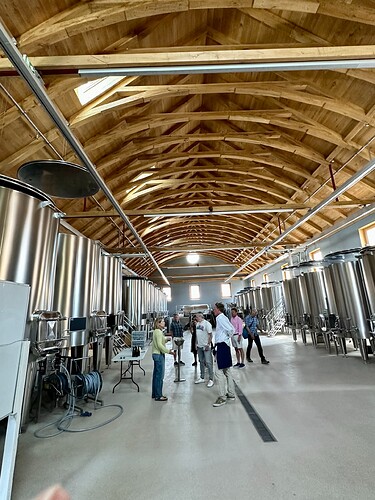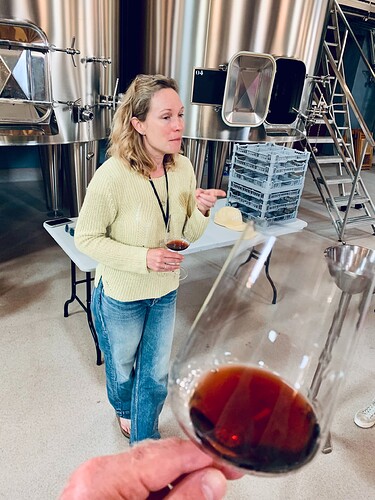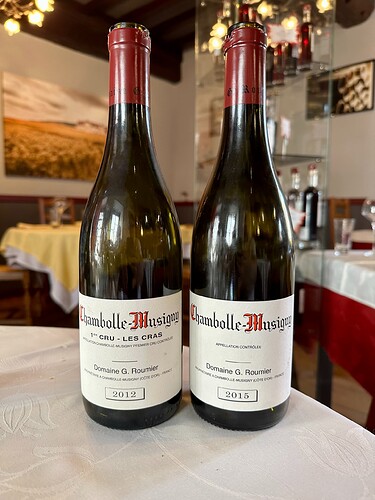Visiting Domaine Dujac
Our visit to Domaine Dujac began inauspiciously.
We prided ourselves on getting to the estate in Morey St. Denis 10 minutes early Tuesday morning after a two-hour drive from Chablis. We parked our vehicle well on the side of a road right next to the Dujac property. We butted up against the first few rows of what we assumed were Dujac’s village MSD vines.
Wrong.
A somewhat perturbed looking vineyard worker – whom we had seen earlier driving by on his tractor – flagged us down the road. He explained in broken English that we had blocked access to his family’s vines. The entitled, SUV-driving Americans strike again! Embarrassing.
We made our way inside the estate, where we greeted briefly by the man himself – the patriarch Jacques Seysses. Goose bumps. A gorgeous Vizsla dog sauntered by. After a few minutes, Diana (Jacques’ daughter in law and the winemaker at Dujac) joined us, apologizing for being tardy as she was a one-woman show for the day. Her husband Jeremy (who oversees the vineyards amongst many other duties) had left for an adventure ski trip in the Arctic Circle with Eric Rousseau and a few other local winemakers. Very butch!
Diana, who also makes the wine at her Snowden family estate in Napa, took us on a brief tour of the vineyards surrounding the family compound. I’ve stated many times that Dujac’s straight village MSD is one of the most consistent, savory and relatively affordable value plays in all of Burgundy. MSD has a kind of lovable, shaggy dog quality that I like. They aren’t cerebral wines. So it was a trip to see the vines first hand.
She explained the sustainable practices the family is applying in the field, pointing out some of the wild vegetation between vine rows. The ground cover helps with carbon capture, she said. When we told her about the tractor infraction, she chuckled, saying relations between competing vignerons can be tricky. She pointed out a big tree in the middle of the Dujac vines that her neighbors might wish to be removed for better sunlight on their vines. She gets and gives a little stink-eye at times, especially when she sees the use of herbicides from farmers working rows near the Dujac vines. (The family now works 22 ha of vines, up from the 4 Jacques started with).
I’ve met Diana a few times at various La Paulee events. I’ve always appreciated her honesty and sunny disposition. With her natural beauty and brainy candor, she reminds me of a mid-career Mia Farrow. She isn’t cagey, like many winemakers I know. She tells you that she’s watered back wines at Dujac. And while her whites are getting infinitely better, she admits her heart will always be with the red wines. She doesn’t hesitate to call herself and me “old,” despite my protestations that we are merely “older.” “No, we’re old!” she says definitively, arguing that she has a duty to make her winemaking more resilient to ensure her two sons and the children of other Burgundy families will have a future on the land.
Walking to the family’s new state-of-the-art LEED-like winemaking facility, she further endeared herself to me. I found out she grew up in Albany, Calif., a small town that sits adjacent to my alma mater U.C. Berkeley. She’s also a Deadhead like me, and got to see Jerry Garcia a few times before his 1995 death…
The family should be proud of their new facility, which resembles something out of Dwell magazine – natural blonde wood, cathedral ceilings, and high window panes that funnel dappled light into the building. Double steel tanks allow for easier one-stop fermentation, bottling and sterilization. I didn’t catch all the details but the tank room also does a remarkable job of capturing the carbon dioxide produced by making the wine. The cellar floor is open to the ground, with no concrete at all, allowing humidity to fill the room naturally.
Diana got us started with a few 2021s – a village MSD and the Grand Cru Clos de la Roche, perhaps the estate’s flagship wine. One sniff of the MSD and you knew you were in Dujacville, with the whole cluster spice and ebullient briary plummy/blackberry fruit. A bit of structure clamps down on the backend, and the tannins are a bit drying at the finish – probably a byproduct of the challenging short vintage. Still, it’s a vibrant, honest wine.
The CdlR had much more extraction and density, with a bit of reduction making it hard to fully assess. Menthol and muscle. It seems a little lighter in the mouth than a typical Dujac CdlR, but that’s to be expected in the vintage, no?
Diana then set up a very cool survey for our group – assorted vintages of Dujac’s super 1er cru Vosne Malconsorts. She explained the backstory of how the family acquired the vines from Moillard in 2005 in a deal negotiated with the Montille clan. The 2006 marks the first Malconsorts that Dujac made, soup to nuts. After nearly two decades, Diana feels she’s starting to really understand the plot, which sits right next to La Tache. I once asked Jeremy what his favorite wine he ever helped make is, and he quickly replied the 2020 Malconsorts. Diana just rolled her eyes when I relayed the story.
Lo and behold, the first wine we try is the 2020 Malconsorts. It is a thing of beauty – regal, plump but sinewy, bursting with extract. Jeremy may be proven right in 15 years!
Diana next opened up the 18, which was lighter on the nose and more red fruited. Then the 11, which had a bit of parmesan-rind funk at first. A slight tinge of auburn-brown bricked the edge of my tasting glass. We swirled and the whole group remarked that we didn’t see any sign of the dreaded lady-bug taint of the vintage. Diana went into a spiel about steps taken to avoid any green, vegetal notes in the challenging vintage. We congratulated her a bit.
Then we sampled the 06, which had better color but seemed a little thin on the palate to me. Group think kicked in and my colleagues – who despise 06 for inane reasons – pooh poohed the wine and politely indicated that it seemed successful for a challenging year. Just a bit too austere for them.
Then a funny thing, happened.
Diana laughed and said “Oh, my god. I’ve poured the wrong wines!” She had mixed up the 06 and the 11. She started giggling, laughing at how the winemaker-speak she had been giving about each vintage in the glass had been totally undermined by her mistake. I loved that she could have a goof at her own expense. I bet many winemakers would’ve said nothing and just let us walk out the door with our own initial impressions. Another sign of character, in my book.
Diana talked about oak and climate change. She feels that shorter fermentation times will lead to less use of oak in the years to come. (The GCs now get about 70% new oak, if I remember right.) She feels that concete foudres may be the future of winemaking in Burgundy. Several winemakers echoed this thought during our trip, and many are experimenting with concrete.
Diana had to run, so we took a few photos and said our goodbyes.
We stopped for lunch in the adjacent village of Chambolle Musigny. An importer friend had recommended Le Chambolle, which features very traditional food in a very traditional rural dining room. The escargots and beef bourguignon were serviceable, the stemware underwhelming and the wine list a bit pricey. We had to console ourselves with a 2012 Roumier CM Cras (cool and stony but a bit closed) and a 2015 village CM (yum). You do what you have to do.
Next: Dropping in at the Gibourg Sisters and day drinking at Captain Red Pants’ new wine bar




